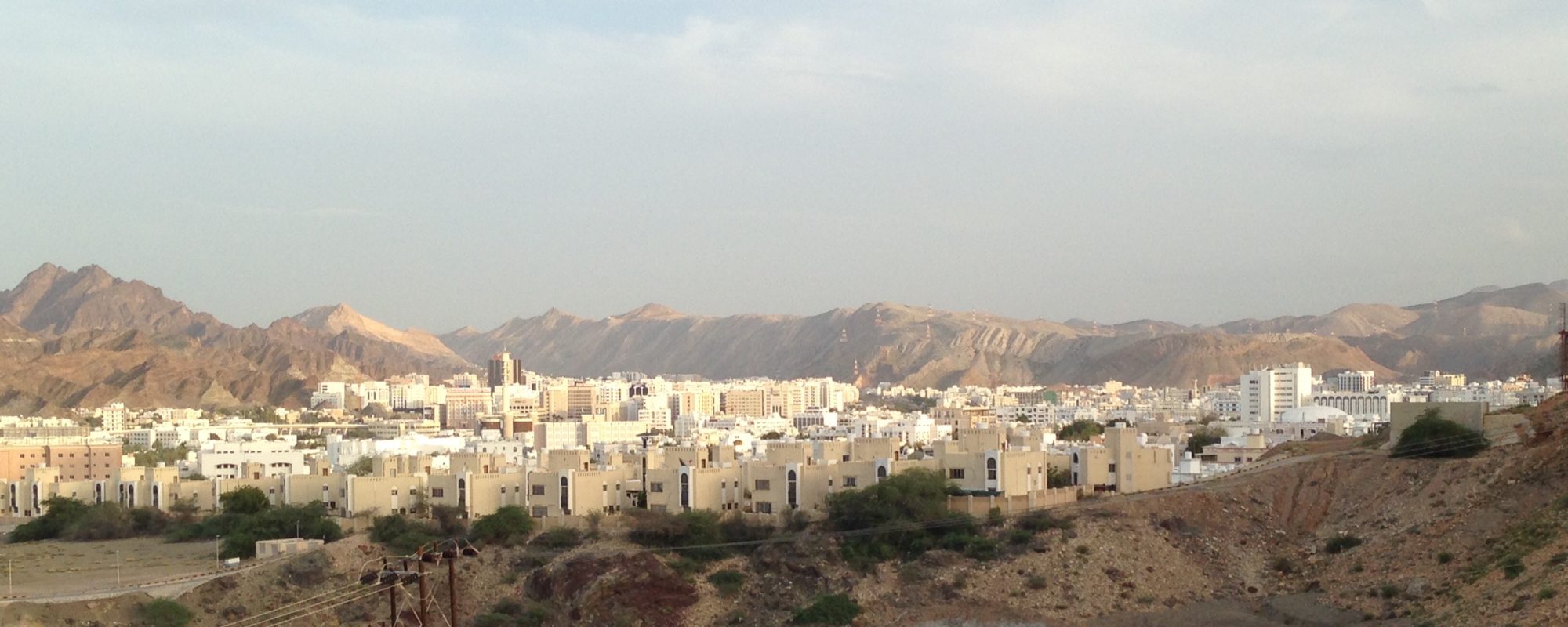“Our journey of development has been and will remain a race for excellence; a race to consolidate Dubai’s position as an evolving, leading, and unrivalled contender for the title of the Middle East’s financial and commercial capital” — H.H. Sheikh Mohammad bin Rashid Al Maktoum, Ruler of Dubai[i]
“We should be open to the experience of other [countries] to enrich the Omani experience, without imitating [them] for the sake of imitation… The benefit of the people is the object of all our development programs” — H.M. Sultan Qaboos bin Said, Sultan of Oman[ii]
It’s a 45-minute flight from Muscat to Dubai, but the two cities feel a gulf apart. In public imagination, Dubai is a city of the future, characterized by superlatives: the world’s largest shopping mall, the largest man-made island, and, at over a half-mile tall and a whopping 163 floors, the world’s tallest building. Gleaming and improbable skyscrapers loom over the narrow corridor of Dubai’s main drag, Sheikh Zayed Road. The soaring presence of the skyline is even felt in the city’s peripherals, a constant backdrop and physical reminder of the Dubai’s extraordinary and rapid ascent.
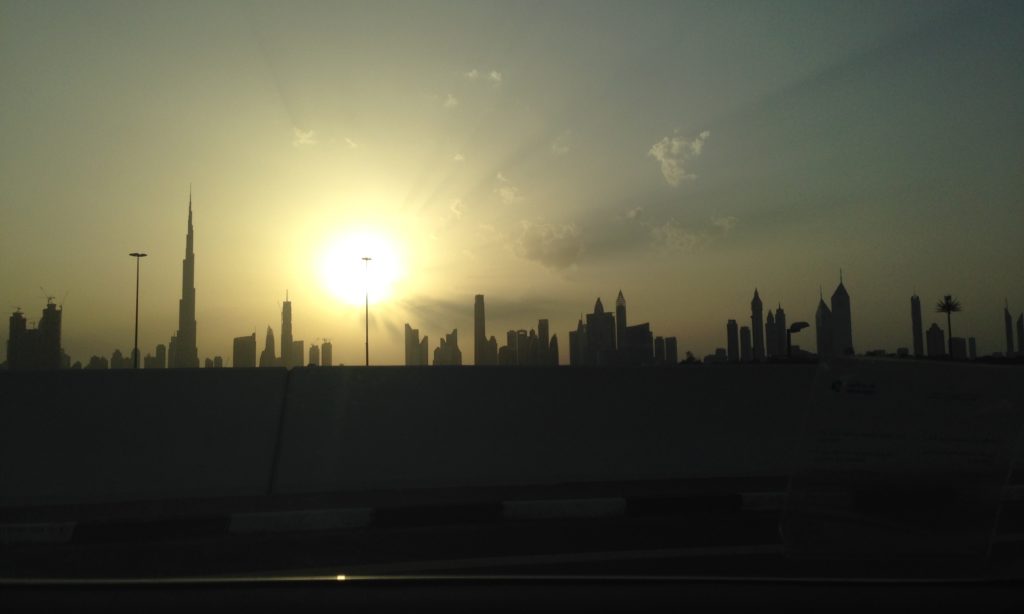
In Muscat, the tallest building is 17 stories high, and most buildings that line Sultan Qaboos Street are no more than 12 floors. In place of skyscrapers, a curtain of dark, craggy mountains characterize Muscat’s skyline, always in view through a window or towering over the roof of a building. Historically, Muscat and Dubai were two ports-of-call for merchants, pirates, and pearl divers on the long coast of Trucial Oman. For centuries, Muscat was the larger and more dominant, but needless to say things have changed. The 21st century cities of Muscat and Dubai are a study in contrasts.
I’ve had a number of visitors in Oman over the past month, all of whom have relayed a similar sentiment — Muscat wasn’t at all what they had expected. After connecting in Dubai or Abu Dhabi or Doha and landing in Muscat, it’s immediately perceptible that there is something different about Oman. The difference goes beyond the physical space of the city, but the glaring divergence in their urban character is a good place to start.
I first visited Dubai in 2009, when epitaphs of the city’s meteoric rise were being written in every major publication after the 2008 financial crisis. It was November, and the government of Abu Dhabi had yet to announce the bailout that would ultimately rescue their beleaguered neighbor. An air of uncertainty pervaded Dubai — the world’s largest concentration of cranes was in the city, but from my hotel window they looked frozen, and unattended block-sized foundation holes looked like enormous graves dug for existing buildings. The then-new Dubai metro was vacant, with only a few riders curiously swiping their cards in the futuristic turnstiles. The financial crisis affected Muscat, too, but in less obvious ways. There were few major development projects left unrealized, and no half-finished skyscrapers to serve as monuments of failure. The biggest project to draw ire was the then-unfinished Royal Opera House Muscat, which some conservative elements derided as an excessive (and haram) waste of government money.
Today, the Dubai Metro is packed to the rafters at all hours of operation — the only place where one might be afforded a modicum of personal space is the ladies’ car, which I of course cannot ride in (Emily, however, enjoys stretching her legs there). In 2016, the half-finished buildings and cranes don’t serve as an eerie reminder of gluttonous spending as they once did — instead they are proof of Dubai’s resilience and seemingly inescapable success. Muscat has changed since 2009, but in subtler ways. The roads are wider, new malls blend in with the old ones, and the Opera House has gathered a layer of sand on its windward side, its stone arches and fortress-like construction providing a timeless look. Dubai has experienced explosive growth (again). Muscat has matured.
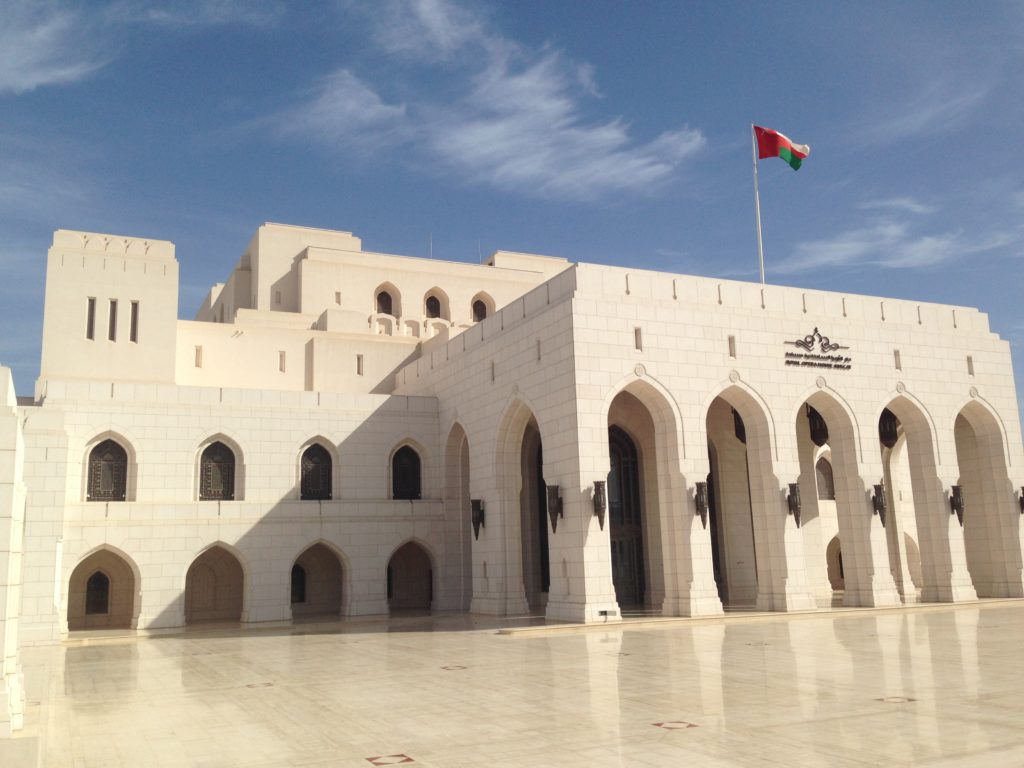
The Arab states of the Persian Gulf are often conflated or portrayed as homogenous or too small to differentiate. Is Doha in the U.A.E.? Is Dubai or Abu Dhabi the one with the indoor ski slope? The reductive idea that backward “nomadic tribes unchanged for millennia suddenly found themselves enriched beyond belief”[iii] permeates many discussions of the Gulf, especially among passers-through. These tropes about the opulence and excess of oil-rich Arab kingdoms are buffeted by depictions in movies and other media where Dubai is an alternate Las Vegas, and entire cities are crude paint-by-numbers approximations of urban life.
To those who haven’t visited, Oman is often lumped in with this idea; after all, it is a member of the Gulf Cooperation Council on the Arabian Peninsula that draws the majority of its wealth from oil rents. There’s a saying that one should “go to Dubai if you’re single, Abu Dhabi if you’re married, and Muscat if you’re retired.” While this was likely intended as commentary on the nightlife in Muscat (or lack thereof), I find it a useful encapsulation of the character and vibe of each city.
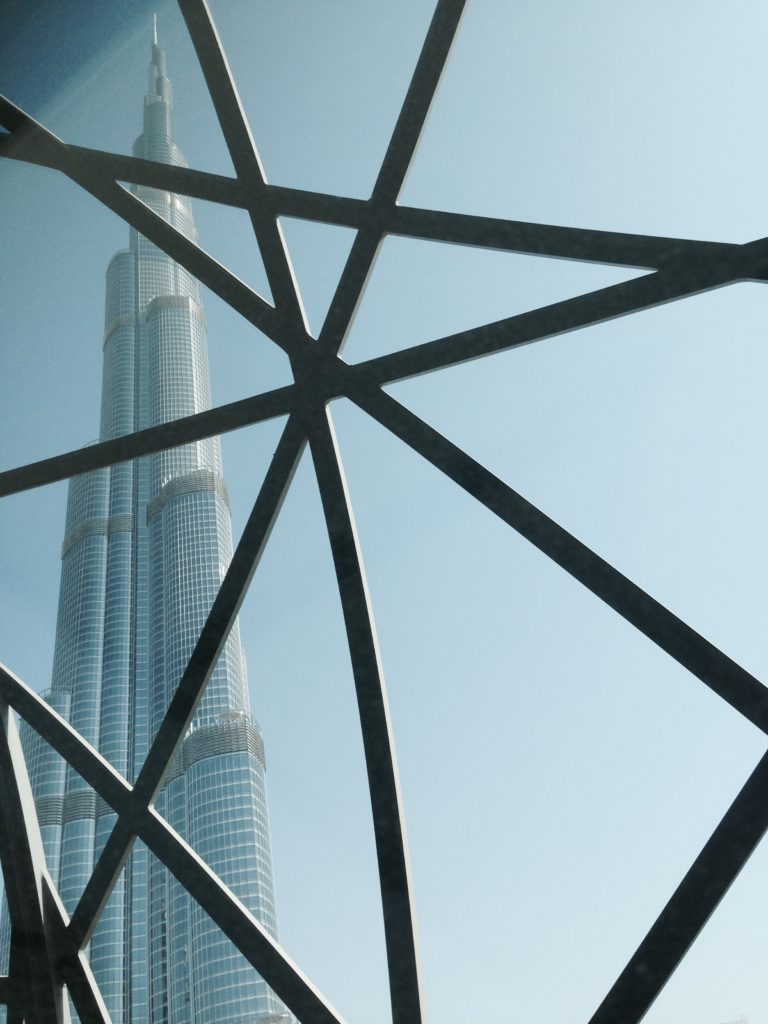
One of my visitors this month was eager for me to show him “downtown Muscat,” a request that might sound straightforward, but gave me pause as I considered where exactly downtown might be. Muscat is a long and thin city that yawns along a coastal strip between the rocky Hajar Mountains and the blue-green waters of the Gulf of Oman. Driving westward on Sultan Qaboos Street is like taking a chronological tour of the capital city’s development. After leaving the ancient ports of Old Muscat and Muttrah (the historical extent of “Muscat” until around 1950), one encounters increasingly newer neighborhoods as road continues. First, just over a mountain pass, the site of Oman’s first restaurant and original landing strip-cum-airport; then, the site of the Sultanate’s first oil refinery, its gas flare flickering day and night. From there, the first planned residential neighborhood, and a labyrinthine commercial district that is now the geographical center of the city. Beyond these neighborhoods are the residential areas and the new airport, built near Seeb, a fishing village that was gradually swallowed into Muscat.
In Muscat, ‘downtown’ is more of a relative concept; for example, a resident of a neighborhood might consider the commercial area nearest to Sultan Qaboos Street their own ‘downtown’ (for example, downtown Seeb). The absence of tall buildings or other congregational landmarks give the entire city the feeling of being a large beachside suburb. And most Omanis want to keep it that way. A lot of locals mention traditional tastes and values, and insist that they don’t want to be Dubai, reflecting the development plan laid out His Majesty Sultan Qaboos, focused on tradition, moderation, and measured growth.
Traditional motifs are required on buildings that face main roads, and often manifest as arched windows and doors, roof-edges lined in pointed merlans in the style of Omani forts, or latticed mashrabiya porches and windows. Even the water tanks that sit on top of nearly every Omani building have the merlan motif, making each tank resemble a tiny alabaster fort. Author Sergey Plekhanov has said that there “are few countries in the world whose architecture is determined to such an extent by the taste of its ruler,” citing an interview with His Majesty where he famously said “I particularly hate glass buildings… But of course we don’t interfere with interior decoration.”[iv] Needless to say, there are few buildings with glass siding.
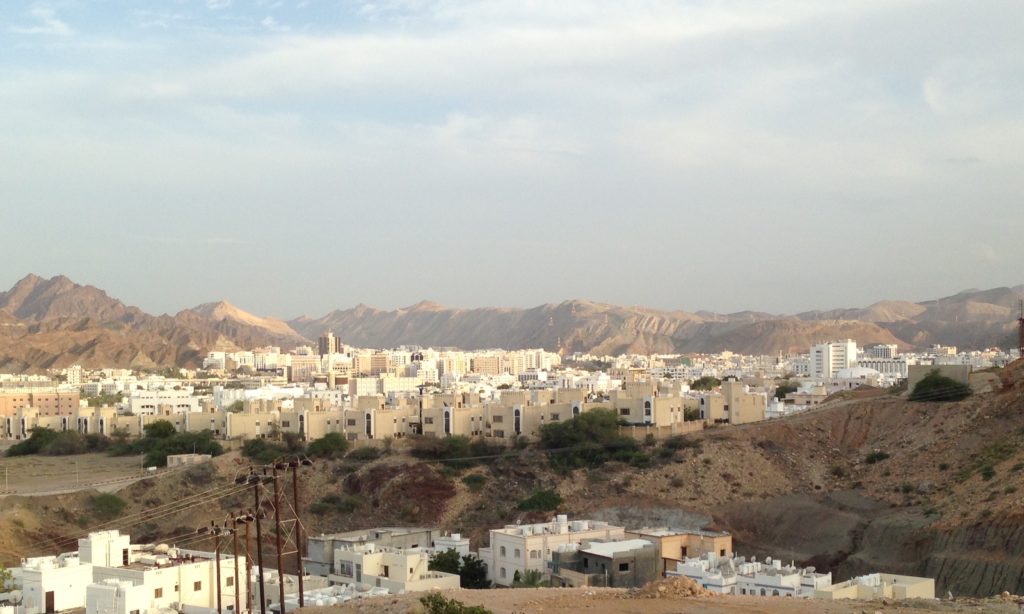
Dubai is almost entirely the opposite, engaging both horizontal and vertical — a meadow of glass buildings stretching toward the sun, with the occasional Islamic motif at eye level on the ground floor. If an architectural style could be ascribed to Dubai, it might be ‘aspirational’ — the late starchitect Zaha Hadid has called Dubai’s ever-evolving skyline a “remarkable message of optimism for the Arab world.”[v] The physical similarities between Muscat and Dubai begin and end with their snake-like sprawl and their wide open roads. To an extent, both cities follow a development model that anthropologist Sulayman Khalaf has called a “particular type of ‘oil city’” — in that oil has shaped the cityscape financially, and not in industrial way.[vi] According to Khalaf, the Gulf oil city is characterized by a number of factors: coastal locations, exponential growth, diverse and numerous migrant communities, and stratified housing systems. But importantly, most of Khalaf’s evidence draws from examples in Dubai, Abu Dhabi, and Doha — Muscat is the outlier.
But beyond the differences in physicality of urban space in Muscat and Dubai, a palpable interpersonal element separates Muscatis and Dubaians. Another visitor of mine, who lives and works in the Emirates, said he was “struck by seeing Omanis in customer service roles,” and was amused by how often locals chatted us up during his stay. Omanis are bus and truck drivers, fishermen, grocery store cashiers, security guards, receptionists, airport employees — and many of these professions are enshrined in law as being reserved for Omanis.
Taxi drivers, for example, must be Omani, and they must wear Omani national dress when they drive their taxi, one such profession that falls under the umbrella of the Omanization development policy. Aside from decreasing unemployment (its primary purpose), the policy makes taxi drivers and other Omani customer service workers de facto ambassadors of Omani culture to visitors — for tourists, hopping in a taxi and testing out your Arabic is quintessential part of the Muscat experience. In Dubai, taxi drivers are almost uniformly South Asian, from Nepal, India, Pakistan.
Part of this is sheer demography, as expatriates far outnumber nationals in the United Arab Emirates: according to the Gulf Research Center, 88.5 percent of residents in the U.A.E. are expats. Oman remains an outlier among GCC states, as nationals still make up the majority, with 44 percent expatriates. The same colleague who was struck by seeing Omanis work normal jobs said that the sheer number of Omanis around Muscat surprised him, as he sees Emiratis “only rarely,” and “generally when they’re shopping.” But the lack of Emiratis in service positions can’t be chalked up to demographics alone.
Last fall, a camera crew followed an Emirati national while he “willingly ditched his Nissan Patrol for four hours to get behind the wheel” of a luxury taxi.[vii] The stunt resulted in a short video and an article for the U.A.E. magazine Sail. The Emirati hoped that he could do his part to “challenge misconceptions” about U.A.E. nationals and work.
“What are your thoughts on someone wearing what I’m wearing driving you around?” he asked his passengers.
“The experience was amazing,” he said after giving a ride to three expatriate passengers, adding that he felt they learned “a little bit about the U.A.E. that they wouldn’t get from someone else.”
“When you serve others, it’s a service, you’re just serving, it doesn’t make you a servant or a slave or however you want to view it,” he concluded. Overall, the exercise was well intentioned and an important step for Emiratis, but seems tone-deaf when viewed from Oman, where hundreds of nationals make a living on cab fares.
Of course, degrees of entitlement are relative. That driving a taxi is mundane in Oman is just one indicator that the threshold for “respectable” professions is lower in Oman. An op-ed in an Muscat newspaper this month criticized this attitude:
“Younger Omanis in their twenties, especially first time job seekers, have misplaced expectations,” regular contributor Saleh Al Shaibany wrote.[viii] “They shun positions that match their background because the jobs on offer are ‘beneath’ them.”
Even Sultan Qaboos has repeatedly addressed the issue, saying that Omanis are “used to hard work and it is not our style to be lazy or negligent, but [instead] to responsibly and honestly carry out our obligations.” [ix] In another speech he glorified the benefits and necessity of manual labor, saying “It is shameful to permit false pride to provide an excuse that such work is beneath one[self].”[x]
Perhaps because these direct admonishments, many Omanis consider themselves as harder-working and more salt of the earth than their Emirati counterparts. Scholar Marc Valeri has said that specifically, the Emirate of Dubai is an object of both “fascination and repulsion” for Omanis.
“Fascination for this city and its inhabitants, not so long ago dependent on the power balance in Oman but now, within a generation, a paroxystic emblem of economic opulence,” noting how Dubai had rapidly and alarmingly surpassed Muscat as a critical center of importance. And “repulsion aroused by the impact, from the Omani point of view, of this material wealth on the ways of thinking of Dubai inhabitants.” I asked an Omani colleague who travels to Dubai several times per year what she thought of the city and its residents.
“I don’t really engage with many Emiratis. They do exist, but,” she trailed off, alluding to the ‘endangered’ status of Emiratis in a city with so many expatriates.
She has cousins and other family members who live in Dubai, who she says have “transformed into Emiratis.” When I asked her to elaborate, she said that their accent, clothes, and their ‘lifestyle’ had changed, pausing to formulate what she meant by this.
In Oman, “even if you are rich, you don’t talk about luxury,” adding that she only just recently learned that a friend she was eating with was member of the Omani royal family. “But the culture in the Emirates, they have this concept that you have to live a lavish life.” I explained the English idiom ‘putting on airs,’ and she nodded.
“Yes, that. Exactly that.”
Officials in Dubai just announced the construction of a new tower set to be taller than Burj Khalifa, the tallest building in the world. Emaar Properties, who also built Burj Khalifa, said the new project was “inspired by the hanging gardens of Babylon,” and will surpass its previous architectural triumph that stands at 828 meters. Muscat is also set to unveil its own height record soon: the airport’s new air traffic control tower, which at just under 100 meters will narrowly surpass both the Ruwi radio tower and a minaret of Sultan Qaboos Grand Mosque as the city’s tallest structure.
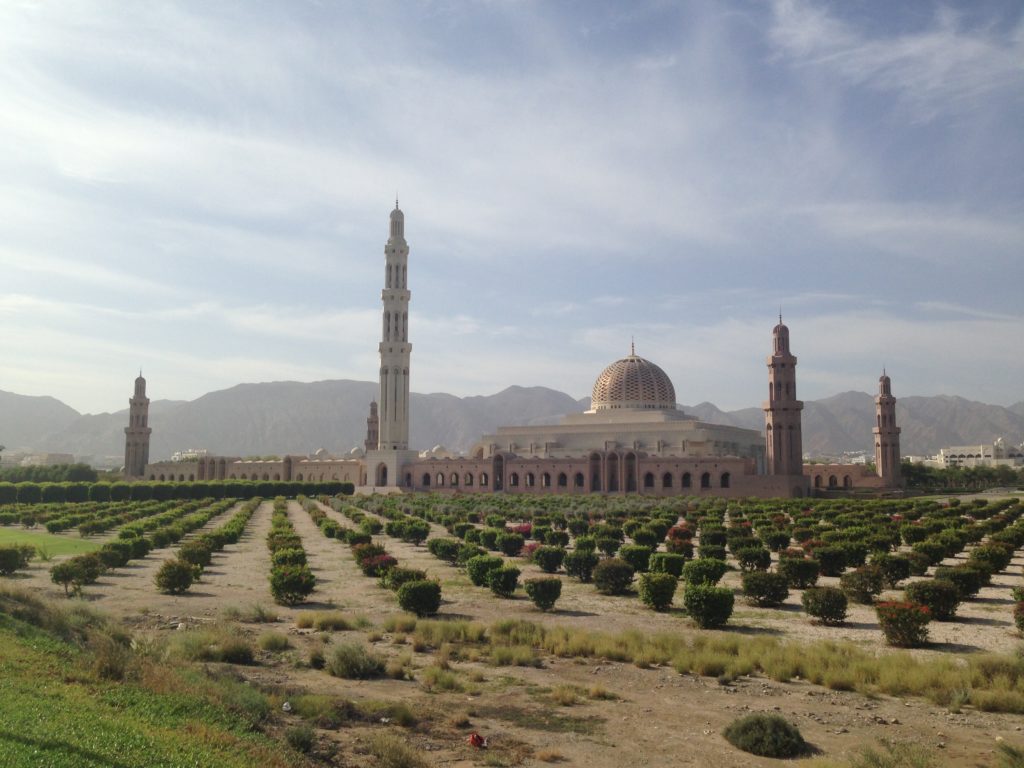
So much of a city’s psyche is tied to its skyline. Imagine New York City. The Empire State building is a classic icon American industrial success, Rockefeller Center is synonymous with entertainment, and One World Trade Center encompasses that unique New York combination of resilience and grit. Paris’s skyline intentionally showcases the Eiffel Tower, which soars above the rest of the city’s eclectic but stunted buildings, looking romantic in all senses of the word. Washington, D.C. is another city that enforces height limits, to ensure its neoclassical monuments to the democratic experiment don’t go unnoticed.
If a city’s architectural choices can be seen as a reflection of the values of its inhabitants, the messages from Dubai and Muscat are clear. As Dubai races toward a superlative and abstract futuristic excellence, Muscat draws on its past to build a sturdy and restrained city within its means, set apart from its peers by its humility.
[i] http://sheikhmohammed.ae/en-us/Pages/Quotes.aspx
[ii] https://www.mofa.gov.om/?p=952&lang=en
[iii] https://www.bostonglobe.com/ideas/2013/12/01/dubai-future-cities/5WcREp0dk9GenHEFPzpsqO/story.html
[iv] Sergey Plekhanov, Reformer on the Throne: Sultan Qaboos bin Said al Said p. 258
[v] http://gulfnews.com/culture/architecture/zaha-hadid-a-bold-and-dramatic-architect-1.1584985
[vi] Sulayman Khalaf, “The evolution of the Gulf city type, oil and globalization” in Globalization and the Gulf p. 245-263
[vii] http://www.thenational.ae/blogs/scene-heard/emirati-khalid-al-ameri-on-being-a-careem-taxi-driver-for-a-day
[viii] http://timesofoman.com/article/79257/Opinion/Columnist/Need-to-bridge-job-skills-gap-in-Oman
[ix] http://www.mepc.org/journal/middle-east-policy-archives/vision-oman-state-sultananate-speeches-qaboos-bin-said-1970-2006?print
[x] Ibid.

